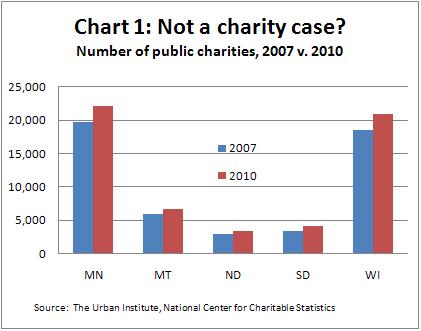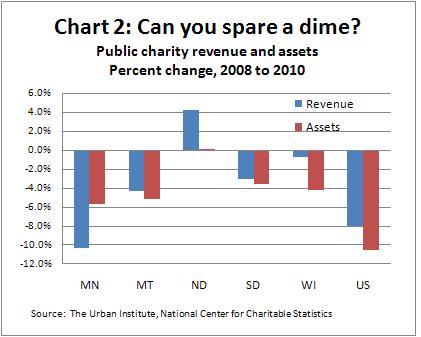A sluggish economy and high unemployment have reinforced the importance of safety nets and other support offered by public charities. But organizations trying to help those in need have also been socked by the recession, as revenues have fallen.
IRS data show that the number of registered public charities (those requesting employer identification numbers and tax-exempt status) has actually grown since 2007. Despite the recession, annual figures for district states and the nation show not a single year in which the number of public charities fell between 2007 and 2010 (through September), according to the National Center for Charitable Statistics (see Chart 1).

But other metrics suggest that public charities have suffered considerably from the recession and slow recovery. Since peaking in 2008, both revenues and assets of public charities nationwide have declined significantly (see Chart 2). Among district states, almost all have seen declines in revenue and assets; Minnesota has fared the worst, with a revenue decline of 10 percent since 2008. This represents a considerable pivot; from 1998 to 2008, revenue at public charities roughly doubled across the nation.

The role of the economy on public charities can really be seen through North Dakota. One of the few states that largely escaped the recession, it was the only district state to see revenue growth (of 4 percent) since 2008. It also eked out a small gain in assets over this period.
Revenue trends are probably even less favorable at the organizational level than they appear on the whole. In 2007 the IRS announced stricter requirements for tax-exempt organizations to file so-called 990 reports, which obligated more small organizations to report their annual revenues and other financial information. (Many religious and government-affiliated organizations, as well as those with gross receipts under $25,000 are still exempt from filing 990s.) Organizations were also given a three-year reporting window before losing their tax-exempt status.
From 2007 to 2010, the annual number of 990 filers grew by 70 percent in district states, though most of the growth is believed to be among very small organizations. This is notable because revenue and asset figures are based on 990 returns; so revenue and assets have shrunk while the organizational base has grown.
Ron Wirtz is a Minneapolis Fed regional outreach director. Ron tracks current business conditions, with a focus on employment and wages, construction, real estate, consumer spending, and tourism. In this role, he networks with businesses in the Bank’s six-state region and gives frequent speeches on economic conditions. Follow him on Twitter @RonWirtz.





